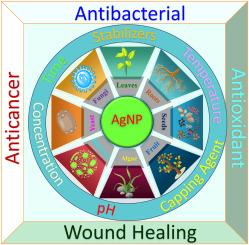银纳米粒子的绿色合成:方法、影响因素和应用综述
Q3 Materials Science
引用次数: 0
摘要
本综述探讨了银纳米粒子(AgNP)绿色合成的最新进展,重点关注基于植物的方法、关键合成因素和生物医学应用。植物提取物富含酚类、类黄酮和萜类等还原剂,可促进银离子向 AgNP 的环保型转化。研究了 pH 值、温度、反应时间和银前体浓度等关键参数对纳米粒子大小、稳定性和产量的影响。生物合成的 AgNP 主要通过细菌膜破坏和氧化应激等机制表现出广谱抗菌活性。此外,还讨论了在抗癌治疗、抗氧化疗法和伤口愈合方面的新兴应用。此外,还强调了绿色合成相对于传统化学方法的优势,以及可重复性、可扩展性和细胞毒性方面的挑战。未来的研究方向包括标准化合成方案、开发大规模生产策略以及进一步研究 AgNP 的毒性机制。植物介导的绿色合成是生成具有重大生物医学潜力的 AgNP 的一种前景广阔的可持续方法。本文章由计算机程序翻译,如有差异,请以英文原文为准。

Green synthesis of silver nanoparticles: A comprehensive review of methods, influencing factors, and applications
This review explores recent advancements in the green synthesis of silver nanoparticles (AgNP), focusing on plant-based methods, critical synthesis factors, and biomedical applications. Plant extracts, rich in reducing agents like phenols, flavonoids, and terpenoids, facilitate the eco-friendly conversion of silver ions into AgNP. Critical parameters such as pH, temperature, reaction time, and silver precursor concentration are examined for their impact on nanoparticle size, stability, and yield. The biosynthesized AgNP demonstrate broad-spectrum antimicrobial activity, primarily through mechanisms like bacterial membrane disruption and oxidative stress. Emerging applications in anticancer treatments, antioxidant therapies, and wound healing are also discussed. The advantages of green synthesis over conventional chemical methods are highlighted, alongside reproducibility, scalability, and cytotoxicity challenges. Future directions include standardizing synthesis protocols, developing large-scale production strategies, and investigating AgNP toxicity mechanisms further. Plant-mediated green synthesis represents a promising and sustainable approach for generating AgNP with significant biomedical potential.
求助全文
通过发布文献求助,成功后即可免费获取论文全文。
去求助
来源期刊

JCIS open
Physical and Theoretical Chemistry, Colloid and Surface Chemistry, Surfaces, Coatings and Films
CiteScore
4.10
自引率
0.00%
发文量
0
审稿时长
36 days
 求助内容:
求助内容: 应助结果提醒方式:
应助结果提醒方式:


